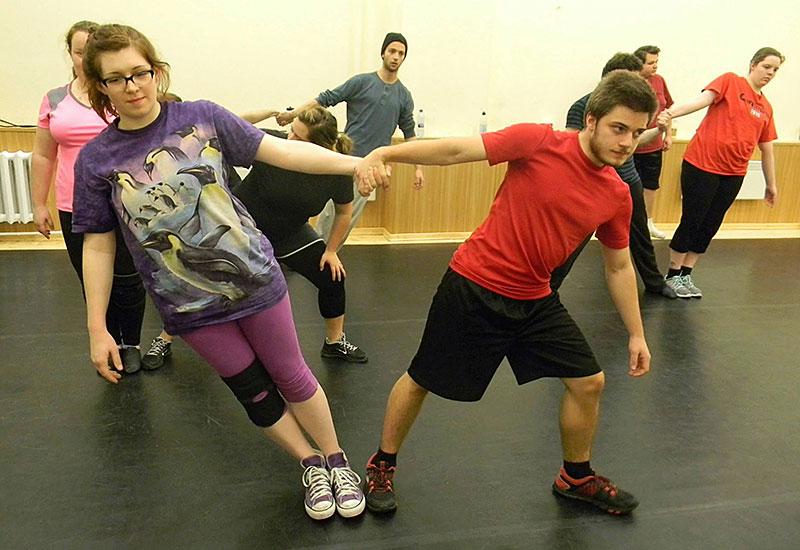Challenging rehearsals—SUNY Oswego students attending classes at the Moscow Art Theatre over winter break found the curriculum—acrobatics, fencing, unarmed combat, stage movement, voice, improvisation and more—rigorous but rewarding.
For 14 SUNY Oswego students, winter break brought a crash course in physical theater and Russian culture during an inspiring—and intense—three-week trip to Moscow.
Henry Shikongo and Jonel Langenfeld of the college’s theater faculty led the group on the visit to the Moscow Art Theatre, home to rigorous training in acrobatics, fencing, unarmed combat, stage movement, voice, improvisation and more.
“I just wanted to facilitate that and make it available to anyone who was inspired to go,” said Shikongo, who as a graduate student at the American Repertory Theater at Harvard spent three months studying at the Moscow Art Theatre. “It is very rigorous training, which the students just experienced.”
The theater school met 9 a.m. to 5 p.m. Mondays through Saturdays. At night, the students were immersed in the artistic life of Moscow. “They were exposed to as much as possible in a very short amount of time,” Langenfeld said.
Junior philosophy and theater dual major Nicholas Cocks said the Moscow experience has been evident ever since he and other travelers in the cast of the spring student honors production, “Circle Mirror Transformation,” have returned to rehearsals at Oswego.
“I was able to apply a lot of the techniques I learned in Moscow in that (play),” Cocks said. “Obviously, it is not something you master right away, you have to keep working at it and working at it.”
Langenfeld said it is no accident the students came back stronger, both physically and in theater skills. The students’ eyes opened wide, for example, when they were introduced to acrobatics, but they kept at it. By the end of the course, every single student was able to do a shoulder stand.
“They forget that it’s pain, because they’re engaged,” Langenfeld said. “It’s very empowering. The pride and self-value they had from that was amazing.”
‘Make it a game’
Moscow was the home of the famed Constantin Stanislavski, the late actor and director whose complex theories and techniques revolutionized acting in the early 20th century, evoking deep, believable and disciplined performances. Stanislavski co-founded the Moscow Art Theatre in 1897.
Cocks recalled how his early attempts at etudes—rehearsed improvisations where an actor tries to reach an authentic emotional place for the character he or she is playing—seemed to fall flat with his instructors. For his final attempt, he took the risk to engage his audience as if they were witness, step by step, to the rise and fall of his love affair with a girlfriend.
“They loved it,” Cocks said. “I was very proud of that moment because I was able to overcome being vulnerable on stage.”
Shikongo said Russian instructors and actors work extraordinarily hard, but certainly without reducing rehearsal to a grim and plodding stereotype.
“In Russia, they really focus on the process,” Shikongo said. “Russians are focused on doing things step by step and just trying. Develop your will and your spirit and—probably the most important thing—have fun, make it light, make it a game. The more they’re sweating, the more they laugh. ‘Smile! Smile! Why so serious?’”
The SUNY Oswego group had plenty of fun, attending numerous performances, including one in which a Moscow Art Theatre instructor appeared. They walked at least four miles a day around Moscow, Langenfeld said.
The state-funded theaters in Moscow “are full every night of the week, from children to the elderly,” she said.




